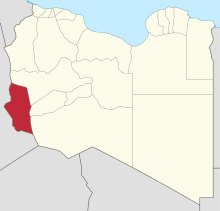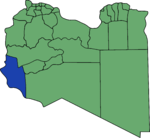Ghat District
| Ghat (Ɣat (Berber) غات (Arabic)) | |
| District | |
 | |
| Country | |
|---|---|
| Capital | Ghat |
| Area | 72,700 km2 (28,070 sq mi) |
| Population | 23,518 (2006) [1] |
| Density | 0/km2 (0/sq mi) |
 Map of Libya with Ghat district highlighted | |
Ghat (Berber: Ɣat; Arabic: غات Ġāt) is one of the districts of Libya. Its capital is Ghat. To the west, Ghat borders two provinces of Algeria: Tamanghasset in the far southwest, and Illizi Province. It also has a short border with the Agadez Department of Niger in the far south. Domestically, it borders Wadi Al Shatii in north, Wadi Al Hayaa in northeast and Murzuq in the east.
Per the census of 2012, the total population in the region was 157,747 with 150,353 Libyans. The average size of the household in the country was 6.9, while the average household size of non-Libyans being 3.7. There were totally 22,713 households in the district, with 20,907 Libyan ones. The population density of the district was 1.86 persons per sq. km. Per 2006 census, there were totally 8,218 economically active people in the district.
Geography

Libya has mostly a flat undulating plain and occasional plateau, with an average elevation of around 423 m (1,388 ft). Around 91 per cent of the land is covered by desert, with only 8.8 per cent agricultural land (with only 1 % arable lands) and 0.1 per cent of forests. The major resources are petroleum, gypsum and natural gas. Along the coastal regions, the climate is Mediterranean in coastal areas, while it is desert climate in all other parts. Dust storms lasting four to eight days is pretty common during Spring.[2] Triplotania is the northwest region, while it is Cyrenacia in the east and Fezzen in southwest.[3] Fezzen is mostly full of deserts. The region receives an annual rainfall of 2.5 in (64 mm). There are no perennial rivers in the region, but the region is abundant with groundwater aquifers.[4]
Administration

Libya became independent in 1951 from the colonial empire and generally known for its oil rich resources. All the powers rested centrally with the President Gaddafi for 42 years till the 2011 armed rebellion which topple him.[5] As per the constitution, Libya is the most decentralized Arab nation, but practically all powers are vested on central government on account of control over the oil revenues. Local governmental institutions manage the administration of education, industry, and communities. As a part of decentralization in 2012, the country is administratively split into 13 regions from the original 25 municipalities, which were further divided in 1,500 communes.[6] Since 2015, the chief of the state is a Chariman of Presidential Council, while the Prime Minister is the head of the state. The House of Representatives is an elected body that is elected on universal suffrage and popular vote. As of 2016, there were 22 administrative divisions in the country in the form of districts.[2]
Demographics
Per the census of 2012, the total population in the region was 157,747 with 150,353 Libyans. The average size of the household in the country was 6.9, while the average household size of non-Libyans being 3.7. There were totally 22,713 households in the district, with 20,907 Libyan ones. The population density of the district was 1.86 persons per sq. km. Per 2006 census, there were totally 8,218 economically active people in the district. There were 4,700 government employees, 1,529 employers, 2,928 first level workers and 000 second level workers. There were 2,703 workers in state administration, 1,419 in agriculture, animal husbandary and forestry, 1,468 in agriculutre & hunting, 1,229 in education, 566 in private enterprises, 670 in health & social work, 369 in production, 1,245 in technical work and 296 service workers. The total enrollment in schools was 8,094 and the number of people above secondary stage and less than graduation was 441.[7] As per the report from World Health Organization (WHO), there were 1 communicable disease centres, 0 dental clinics, 1 general clinics, 0 in-patient clinics, 0 out-patient clinics, 2 pharmacies, 13 PHC centres, 0 polyclinics, 0 rural clinics and 0 specialized clinics.[8]
References
- ↑ "Districts of Libya". statoids.com. Retrieved 27 October 2009.
- 1 2 "Libya profile". 2016. Retrieved 23 November 2016.
- ↑ Otman, Waniss; Karlberg, Erling (2007). The Libyan Economy: Economic Diversification and International Repositioning. Springer Science & Business Media,. pp. 1–3. ISBN 9783540464631.
- ↑ McColl, R. W. (2014). Encyclopedia of World Geography, Volume 1. Infobase Publishing. p. 543. ISBN 9780816072293.
- ↑ "Libya profile - Timeline". BBC. 2 August 2016. Retrieved 20 November 2016.
- ↑ Great Socialist People's Libyan Arag Jamahiriya Public Administration and Country profile (PDF) (Report). Department of Economic and Social Affairs (DESA), United Nations. 2004. p. 9. Retrieved 17 November 2016.
- ↑ "Census of Libya". General Information Authority, Libya. 2012. Retrieved 17 November 2016.
- ↑ "Health statistics of Libya". World Health Organization (WHO). 2007. Retrieved 17 November 2016.
External links
Coordinates: 25°20′N 11°00′E / 25.333°N 11.000°E